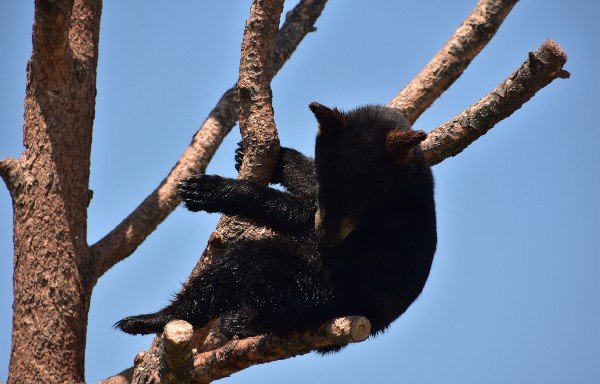Bears are some of the most fascinating creatures on Earth, known for their adaptability and the diversity of environments they inhabit. From the bamboo-filled forests of southwest China, home to the iconic giant panda, to the icy reaches of the Arctic Circle where the polar bear reigns supreme, bears have evolved to thrive in various ecosystems. Their diets are equally varied, shaped by both the availability of food and their physiology. In this guide, we’ll explore the food habits of grizzly bears throughout the year and answer the question: are bears omnivores, carnivores, or herbivores?
A Bear’s Diet Across the Seasons
Spring: Reawakening and Protein-Rich Feasts
As grizzly bears emerge from hibernation in spring, their primary focus is rebuilding strength and restoring fat reserves lost during their long winter slumber. At this time, they mainly feed on ungulates—animals such as deer and elk—that often succumb to the harsh winter conditions or fall prey to wolves. Male grizzlies, in particular, may also hunt elk calves or raid the underground caches of pocket gophers. Alongside these protein sources, they begin to forage for early vegetation, including dandelions, succulent grasses, horsetail, clover, and even ants, which provide a quick, easily accessible food source.
Summer: Berries, Insects, and Plant Foraging
As the warmer months roll in, grizzly bears’ diets expand to include a wide variety of plant-based foods and insects. They continue to graze on clover, horsetail, and dandelions, but as the summer progresses, their foraging shifts to more nutrient-rich plants like fireweed, thistle, biscuit root, and even the protein-packed army cutworm moths, which they can consume in large quantities. Elk calves may still be preyed upon until mid-July, at which point the calves become too agile for the bears to catch. By mid-summer, berries become a vital food source, with species like grouse whortleberry, globe huckleberry, strawberry, and buffaloberry offering an essential burst of calories. As the summer progresses, more starchy underground foods such as bistort, false truffles, and yampa become important parts of their diet.
Fall: Bulking Up for Hibernation
In preparation for the winter hibernation, grizzly bears enter a phase known as hyperphagia, where they eat almost nonstop to store up fat. From September to October, their preferred food is the seeds of whitebark pine trees, a highly nutritious source of energy. However, these seeds are not produced every year, so in years when the seed crop is sparse, grizzlies turn to a wide variety of alternatives, including berries like globe huckleberry and grouse whortleberry, as well as plant roots such as sweet cicely. Other staples during this time include clover, ants, dandelion, and the elusive false truffles that they dig up from the forest floor.
Are Bears Omnivores, Carnivores, or Herbivores?
Bears are classified as omnivores, meaning they eat both plant-based and animal-based foods. In fact, around 70-80% of a bear’s diet consists of plant material. However, bears also need protein and fat to maintain their energy levels, weight, and reproductive health, which they obtain from meat and animal products. This makes them highly flexible feeders, capable of adapting their diet to whatever is available in their environment.
For instance, black bears, which are also found in the Yellowstone ecosystem alongside grizzlies, eat a wide variety of foods that shift with the seasons. In the spring and summer, black bears feast on berries, fruits, and roots. As fall approaches and they prepare for hibernation, their diets shift to include more meat, such as fish, as well as high-fat foods that will sustain them through the winter months. In warmer regions where hibernation is not necessary, black bears continue to rely more on vegetation, fruits, and insects year-round, and they may consume less animal protein than bears in colder climates.
Grizzly vs. Black Bears: Dietary Differences
While both grizzly bears and black bears are omnivorous and share similar diets in the Yellowstone ecosystem, there are notable differences between the two species in terms of how they obtain their food. Black bears have shorter, curved claws that make them excellent climbers but less efficient at digging. As a result, black bears tend to rely more on foraging for fruits, nuts, and berries found in trees. Grizzly bears, on the other hand, have longer, straighter claws that allow them to dig efficiently for roots, bulbs, tubers, and small mammals underground. This digging behavior makes grizzlies more likely to consume a higher percentage of meat and roots in their diet, while black bears often eat more plant matter.
In summary, while grizzly bears are formidable predators capable of hunting large mammals, their diet is largely omnivorous, with a heavy reliance on plant foods, especially during the spring and summer. The flexibility in their diet is key to their survival in diverse habitats and fluctuating environmental conditions. Understanding the dietary habits of bears, especially grizzlies, can give us a deeper appreciation for these incredible animals and the ecosystems they inhabit.
Discover More at Yellowstone Bear World
Are you curious to learn more about the remarkable dietary habits and lifestyles of grizzly bears? At Yellowstone Bear World, you can see these majestic creatures up close and observe their behaviors in a safe, natural environment. Whether you’re a wildlife enthusiast or simply want a unique experience, Yellowstone Bear World offers a rare opportunity to connect with nature. Call us today at (208) 359-9688 to plan your visit and embark on a journey into the wild world of bears!





